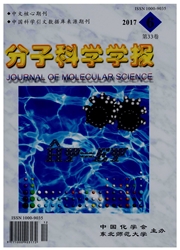

 中文摘要:
中文摘要:
在CCSD(T)/6—311G(d,f)//MP2/6—311G(d,f)+ZPE水平下,计算得到含有8个异构体和11个过渡态的HSCCS自由基体系势能面,讨论了异构体的结构与稳定性及异构体之间的异构化过程.结果表明异构体ml的能量最低,除ml以外,异构体m2和m3的能量也比较低,在MP2水平上,过渡态TS1的能量比异构体m2仅高3.9kJ/mol,而在CCSD(T)水平上,TS1的能量比m2低14.6kJ/mol,这说明异构体rn2可以迅速转化为能量更低的m1.异构体m3的能量比异构体ml高49.99kJ/mol,可以推断,在合适的实验条件下可以观测到异构体ml.
 英文摘要:
英文摘要:
The potential energy surface (PES) of HSCC.S radical including eight isomers and eleven transition states is obtained at the CCSD(T)/6-311G(d,f)//MP2/6-311G(d,f)+ZPE level. The isomerization of HSCCS radical, the structure and stability of isomers are discussed. The calculated results show that the isomer ml has the lowest energy. The isomers m2 and m3 are also with lower energy. The energy of transition state TS1 is higher than that of m2 by 3. 9 kJ/mol at the MP2 level, while it is lower than that of isomer m2 by 14. 6 kJ/mol at the CCSD(T) level. So isomer m2 can easily isomerize into isomer ml. The energy of isomer m3 is higher than that of ml by 49.99 kJ/mol. In certain conditions, we predict that the isomer ml should be observed by experiments.
 同期刊论文项目
同期刊论文项目
 同项目期刊论文
同项目期刊论文
 期刊信息
期刊信息
